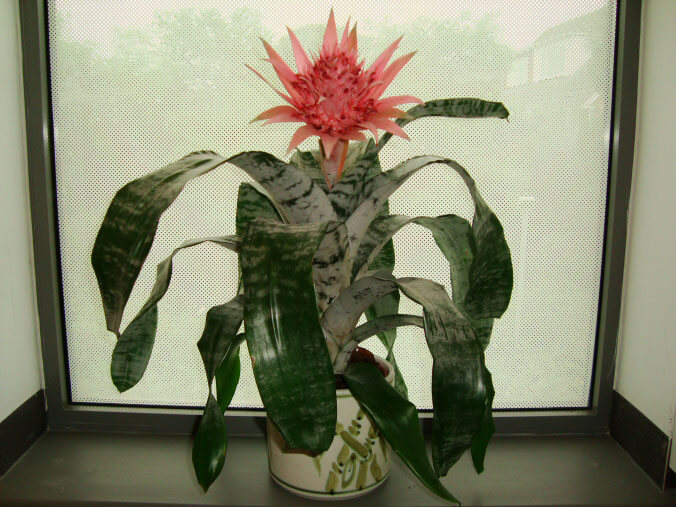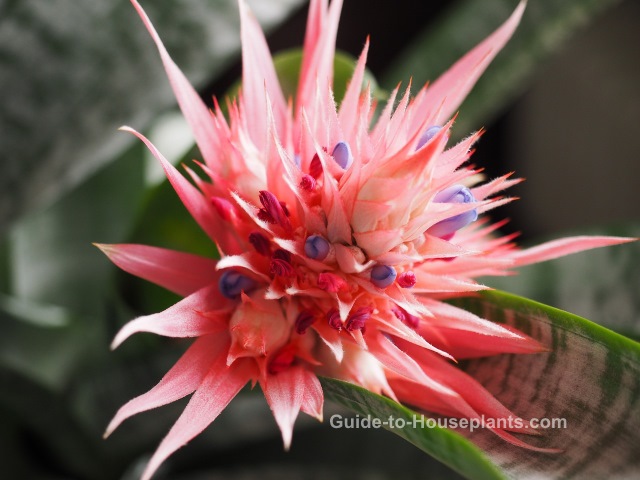To take care of an urn plant, provide it with bright indirect light and water it when the top inch of soil feels dry. Urn plants, scientifically known as aechmea fasciata, are native to the rainforests of brazil and are popular indoor plants due to their unique appearance and low maintenance needs.
These plants have long, arching leaves that form a rosette shape and produce a vibrant pink flower spike that emerges from the center. To ensure the health and vitality of an urn plant, it is important to provide it with the right amount of light and water.
These plants prefer bright, indirect light and should be placed near a window where they can receive filtered sunlight. Direct sunlight can scorch the leaves, so it is best to keep them away from windows with intense sunlight. Watering an urn plant is a delicate balance, as they prefer to be kept slightly moist but not waterlogged. Water the plant thoroughly, allowing excess water to drain, and then let the top inch of soil dry out before watering again. Avoid overwatering, as this can lead to root rot and other issues. With the right care, an urn plant can thrive and add beauty to any indoor space.

Credit: www.ourhouseplants.com
How to Take Care of an Urn Plant: Step by Step Guide
Understanding The Urn Plant
The urn plant, also known as aechmea fasciata, is a popular choice for indoor gardening enthusiasts. With its distinctive vase-like shape, it adds a touch of elegance to any space. This plant is native to brazil and belongs to the bromeliad family.
One of the key features of the urn plant is its long-lasting, vibrant pink flower spike that emerges from the center of its rosette leaves. It creates a stunning contrast against the plant’s green foliage and can last for several months.
There are several varieties of urn plants available, including the “silver urn” with its silver-gray leaves and the “red urn” with its vibrant red bracts. Understanding the urn plant and its characteristics is crucial for providing the proper care it needs to thrive.
Choosing The Right Environment
Choosing the right environment is crucial for the care of an urn plant. The ideal climate conditions should be considered, including the lighting requirements. Providing adequate light is essential for the plant’s growth and development. In addition to lighting, temperature and humidity are important factors to consider.
The plant should be kept in a temperature range that is suitable for its survival. It is equally important to maintain the right humidity level to prevent any damage or wilting of the leaves. By creating a suitable environment with the right lighting, temperature, and humidity, you can ensure the well-being of your urn plant.
Proper Watering Techniques
Watering an urn plant properly is essential to ensure its health and longevity. To determine the watering needs of an urn plant, you should consider factors like its type, environment, and season. Understanding the frequency and amount of watering is crucial.
Typically, urn plants prefer evenly moist soil, but it’s important not to overwater them. Allow the top two inches of soil to dry out between waterings. Take into account the humidity levels in your indoor or outdoor environment. If the air is dry, you may need to water more frequently.
Conversely, if it’s overly humid, reduce the frequency. Also, consider the season and adjust watering accordingly. During the growing season, urn plants may require more water compared to the dormant period. Remember to water the plant thoroughly, ensuring that excess water drains out.
By following these guidelines, you can maintain a healthy urn plant and enjoy its beauty for years to come.
Nutritional Needs
Understanding the nutrient requirements of urn plants is essential for their proper care. Selecting the right fertilizers that cater to these requirements is crucial. It is important to establish a feeding schedule to provide the plants with optimal nourishment for growth.
When feeding urn plants, ensure the use of high-quality fertilizers that contain a balanced mix of essential nutrients. Avoid over-fertilizing, as it can cause nutrient burn and damage the plant. Remember to read and follow the instructions on the fertilizer packaging for accurate application.
Regularly monitor the plant’s progress and adjust the feeding schedule accordingly. By providing the right nutrients at the right time, you can promote healthy growth and vibrant foliage in your urn plants.
Pruning And Trimming
Pruning and trimming are crucial for maintaining the health and appearance of urn plants. Regular pruning helps to control the shape and size of the plant, ensuring that it stays neat and compact. By removing dead or damaged leaves, you prevent the spread of diseases and pests.
It also allows the plant to allocate its resources to healthy growth and development. When pruning, make sure to use clean and sharp tools to minimize the risk of introducing infections. Additionally, avoid cutting too much at once, as it can shock the plant.
Instead, trim in small increments and regularly monitor the growth to maintain the desired shape. Proper pruning and trimming techniques will help your urn plant thrive and enhance the aesthetics of your space.
Managing Pests And Diseases

Urns plants are susceptible to various pests, which can compromise their health and appearance. Common pests include aphids, mites, and mealybugs, which feed on the plant’s sap. To combat these pests, you can use natural remedies like neem oil or insecticidal soap, which suffocate and repel them.
Alternatively, chemical treatments like systemic insecticides can be used. When it comes to diseases, urn plants are vulnerable to root rot and fungal infections. To prevent these, ensure proper drainage, avoid overwatering, and maintain good air circulation. Additionally, regularly inspect the plant for any signs of disease and promptly remove affected leaves or stems.
By actively managing pests and diseases, you can ensure that your urn plant thrives and remains a beautiful addition to your indoor or outdoor space.
Propagation Methods
Reproducing urn plants through stem cuttings is a reliable propagation method. The key question often arises: should you root the cuttings in water or soil? The answer lies in personal preference and experience. For those who choose water, make sure to change it regularly to prevent rot.
On the other hand, planting the cuttings directly into soil can offer better stability and nutrient absorption. Regardless of the method chosen, there are a few tips for successful propagation. Firstly, select healthy and disease-free cuttings. Secondly, trim excess leaves to minimize water loss and focus energy on rooting.
Thirdly, provide a suitable environment with consistent humidity and indirect sunlight. Lastly, be patient and monitor progress regularly. With proper care and attention, propagating urn plants from stem cuttings can yield thriving new additions to your plant collection.
Transplanting And Repotting
Taking care of an urn plant involves proper transplanting and repotting techniques. One sign that indicates the need for repotting is when the plant becomes root-bound, with roots overflowing from the drainage holes. Another sign is when the plant starts toppling over due to lack of support from the pot.

To repot an urn plant, it is crucial to choose the right potting mix, which should be well-draining and nutrient-rich. The steps for transplanting the plant safely include gently removing it from its current pot, loosening the root ball, and placing it in a slightly larger pot with fresh potting mix.
After transplanting, remember to water the plant thoroughly and provide it with proper sunlight and temperature conditions. Following these guidelines will help ensure the health and longevity of your urn plant.
Troubleshooting Common Issues
Yellowing leaves and other discoloration are common issues that urn plant owners may encounter. When the leaves turn yellow or show signs of discoloration, it often indicates a problem with the plant’s health. Drooping or wilting urn plants are another sign of distress.
To revive a struggling urn plant, there are a few helpful tips. First, check the soil moisture level and adjust watering accordingly. Adequate sunlight and proper drainage are crucial for the plant’s well-being. Additionally, inspect the leaves and stems for any signs of pests or diseases.
Removing any affected parts and treating the plant with appropriate solutions can help restore its health. Regular fertilization, pruning, and repotting as needed are also essential for maintaining a healthy urn plant. With proper care and attention, your urn plant can thrive and bring beauty to your space.
Frequently Asked Questions On How To Take Care Of An Urn Plant
How Often Should An Urn Plant Be Watered?
An urn plant should be watered approximately once a week. However, it’s important to allow the soil to dry out slightly between waterings to avoid overwatering. Check the moisture level by inserting your finger into the soil up to the first knuckle.
If it feels dry, it’s time to water the plant.
What Is The Best Location For An Urn Plant?
An urn plant thrives in bright, indirect light. Place it near a window where it can receive filtered sunlight throughout the day. Avoid exposing it to direct sunlight, as this can lead to leaf burn. It’s also important to keep the plant away from cold drafts or extreme temperature changes.
How Should I Fertilize An Urn Plant?
Fertilize an urn plant once a month during the growing season, which is typically spring and summer. Use a balanced, water-soluble fertilizer diluted to half the recommended strength. Apply the fertilizer to the soil, making sure to avoid direct contact with the leaves.
Good drainage is essential, so be sure to allow excess water to drain out of the pot.
Conclusion
To summarize, the well-being of your urn plant hinges on providing the right conditions and committing to regular care. Remember to place it in a spot with sufficient light and proper temperature. Avoid overwatering by checking the soil moisture before each watering session.
Prune your urn plant regularly to maintain its shape and remove any dead or diseased parts. Fertilize the plant during the growing season to supply essential nutrients. Keep an eye out for common problems like pests or diseases and take immediate action if necessary.
By following these simple guidelines and integrating them into your plant care routine, you can enjoy a thriving and beautiful urn plant for years to come. Take pleasure in nurturing this decorative plant and let it bring a touch of nature to your home or office space.

